Your running program is packed with cardio days and sprinkled with strength routines, but that’s not all—it also includes a lot of sweet, sweet rest. This is vital not only because it feels so damn good, but also because you need those days to recover. After all, that’s when your body adapts to the stresses you’ve placed on it, so you can do it all over again (and even better) the next time.
Sometimes, rest days can—and should—be just that, days with zero exercise at all on your schedule. You can take advantage of the time off to do something else that enhances your well-being, whether that’s catching up with a friend, reading that novel that’s been parked on your nightstand, or getting crafty and creative with a few new projects.
But in other cases, you might want to move a little in ways that feel good for your body and mind. Enter: active recovery, or gentle movement that’s a lot less intense than your typical workout. You might choose to take a (light!) yoga class, go for an easy walk, or spend some quality time with your foam roller.
Another option? A quick active recovery routine. Amanda Katz, an NASM-certified personal trainer and running coach in New York City, designed the ones below as part of SELF’s Learn to Love Running Program to complement the strength and cardio workouts that make up the bulk of your plan. These dynamic routines were created to help link your mind and body, centering you so you’re ready to get back to running, lifting, or whatever other more intense activities are on your docket the next day.
The goal here is to move at a slower pace than the rest of the week, gently boosting blood flow while taking your joints through a wide range of motion to improve mobility. Runners who regularly work on mobility may reduce pain and stiffness while also improving performance, Katz says. These sessions also offer an opportunity to notice—and address—any minor imbalances before they turn into pain or injuries. For example, if your right hip feels tighter than your left one in pigeon pose, you can spend a few extra minutes there for an added release.
Feel free to pick and choose which routine to do on any given day, exploring what feels good for your body. Try a new sequence if you want more variety, repeat the ones you like, or even, once you’ve tried them all the way through a few times, mix and match the exercises that work the best for you. Just a note, though, that they’re organized so that the last two may require slightly more mobility than the first two—keep that in mind as you give them a try.
Set aside 15 to 25 minutes for each routine; the exact duration will depend on how quickly or slowly you perform reps, how much rest you take between rounds, and if your body requests a little more TLC in one particular area!
Active Recovery #1
What you need: A bench, chair, couch, or other sturdy surface, a dumbbell to hold, and an exercise mat for comfort.
Directions
- Do 10 reps of each dynamic exercise. For single-sided moves, do 10 reps on each side. For static stretches, hold for the time given.
- After all your reps are done, move on to the next exercise.
- After all four exercises are completed, rest for up to 2 minutes before starting from the top again.
- Complete the circuit 2–3 times total.
World’s Greatest Stretch
Katie Thompson















